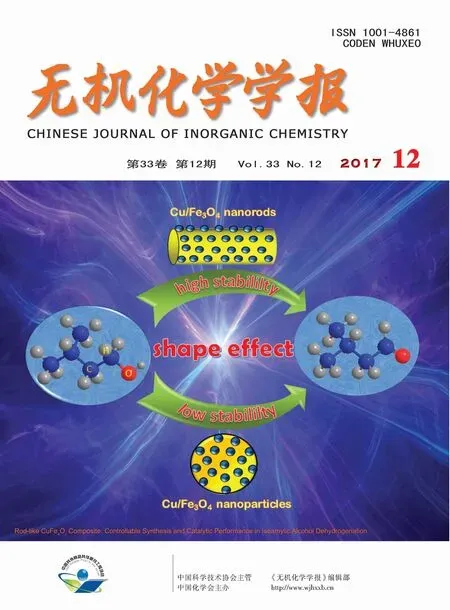由联苯四羧酸配体构筑的一维锰髤和二维铜髤配位聚合物的合成、晶体结构及磁性质
2017-12-13陈金伟温炳松曹芳利邱文达成晓玲
陈金伟 温炳松 曹芳利 邱文达 黎 彧*, 成晓玲*,
由联苯四羧酸配体构筑的一维锰髤和二维铜髤配位聚合物的合成、晶体结构及磁性质
陈金伟1温炳松2曹芳利2邱文达3黎 彧*,3成晓玲*,2
(1广东轻工职业技术学院轻化工技术学院,广州 510300)
(2广东工业大学轻工化工学院,广州 510006)
(3广东轻工职业技术学院生态环境技术学院,广州 510300)
采用水热方法,用 2 种联苯四羧酸配体(2,4-H4bpta 和 3,5-H4bpta)和 4,4′-联吡啶(4,4′-bipy)或 2,2′-联吡啶(2,2′-bipy)分别与 MnCl2·4H2O 和 CuCl2·H2O 反应,合成了一个具有一维双螺旋链结构的配位聚合物[Mn(μ3-2,4-H2bpta)(4,4′-bipy)2]n(1)和一个二维层状配位聚合物{[Cu(μ4-3,5-bpta)0.5(2,2′-bipy)(H2O)]·H2O}n(2),并对其结构和磁性质进行了研究。结构分析结果表明2个配合物分别属于单斜晶系,P21/c和C2/c空间群。配合物1具有一维双螺旋链结构,而且这些一维链通过O-H…N氢键作用进一步形成了二维超分子网络。而配合物2具有二维层状结构。研究表明,配合物1中相邻锰离子间存在铁磁相互作用。
配位聚合物;氢键;四羧酸配体;磁性
In recent years,a high interest has been focused on the design and construction of the coordination polymers due to their potential applications,architectures,and topologies[1-5].Many factors such as the coordination requirements of the metal centers,the structural characteristics of the ligand,the solvent system,and pH value can play the key role in the construction of the coordination networks[6-12].The selection of the special ligands is very important in the construction of these coordination polymers.
Multi-carboxylate biphenyl ligands have been certified to be of great significance as constructors due to their strong coordination abilities in various modes,which could satisfy different geometric requirements of metal centers[8-17].In order to extend our research in this field,we chose two biphenyl tetracarboxylic acid ligands,biphenyl-2,2′,4,4′-tetracarboxylic acid (2,4-H4bpta)and biphenyl-3,3′,5,5′-tetracarboxylic acid(3,5-H4bpta)to construct novel coordination polymers.Both H4bpta ligands possesses the following features:(1)they have four carboxyl groups that may be completely or partially deprotonated,inducing rich coordination modes and allowing interesting structures with higher dimensionalities; (2)they can act as hydrogen-bond acceptor as well as donor,depending upon the degree of deprotonation; (3)two sets of carboxyl groups separated can form different dihedral angles through the rotation of C-C single bonds;thus,it may ligate metal centers in different orientation.
Taking into account these factors,we herein report the syntheses,crystal structures,and magnetic properties of two Mn髤 and Cu髤 coordination polymers constructed from H4bpta.
1 Experimental
1.1 Reagents and physical measurements
All chemicals and solvents were of AR grade and used without further purification.Carbon,hydrogen and nitrogen were determined using an Elementar Vario EL elementalanalyzer.IR spectra were recorded using KBr pellets and a Bruker EQUINOX 55 spectrometer.Thermogravimetric analysis(TGA)data were collected on a LINSEIS STA PT1600 thermal analyzer with a heating rate of 10 ℃·min-1.Magnetic susceptibility data were collected in the 2~300 K temperature range with a Quantum Design SQUID Magnetometer MPMS XL-7 with a field of 0.1 T.A correction was made for the diamagnetic contribution prior to data analysis.
1.2 Synthesis of[Mn(μ3-2,4-H2bpta)(4,4′-bipy)2]n(1)
A mixture of MnCl2·4H2O (0.040 g,0.20 mmol),2,4-H4bpta (0.066 g,0.2 mmol),4,4′-bipy (0.031 g,0.2 mmol),NaOH (0.016 g,0.40 mmol),and H2O(10 mL)was stirred at room temperature for 15 min,and then sealed in a 25 mL Teflon-lined stainless steel vessel,and heated at 160℃for 3 days,followed by cooling to room temperature at a rate of 10 ℃·h-1.Yellow block-shaped crystalsof1 wereisolated manually,and washed with distilled water.Yield:35%(based on 2,4-H4bpta).Anal.Calcd.for C36H24MnN4O8(%):C 62.16,H 3.48,N 8.06;Found(%):C 61.93,H 3.44,N 8.11.IR (KBr,cm-1):1 672m,1 624w,1 598s,1 572s,1 533m,1 489w,1 424m,1 377w,1 303m,1 277w,1 246w,1 216w,1 164w,1 120w,1 064w,1 042w,999w,972w,899w,851w,808m,773w,730w,691w,656w,626w,569w,543w.
1.3 Synthesis of{[Cu(μ4-3,5-bpta)0.5(2,2′-bipy)(H2O)]·H2O}n(2)
The synthesis of 2 is similar with that of 1 except that CuCl2·H2O(0.030 g,0.20 mmol),3,5-H4bpta(0.033 g,0.1 mmol),2,2′-bipy(0.031 g,0.2 mmol)were used instead of MnCl2,2,4-H4bpta and 4,4′-bipy.Blue block-shaped crystals of 2 were isolated manually,and washed with distilled water.Yield:65%(based on 3,5-H4bpta).Anal.Calcd. for C18H15CuN2O6(%):C 51.61,H 3.61,N 6.69;Found(%):C 51.78,H 3.58,N 6.65.IR (KBr,cm-1):3 647w,3 307w,1 604w,1 569s,1 493w,1 472w,1 448w,1 402m,1 356s,1 311w,1 250w,1 174w,1 114w,1 073w,1 052w,1 027w,896w,769m,712w,652w,541w.The complexes are insoluble in water and common organic solvents,such as methanol,ethanol,acetone,and DMF.
1.4 Structure determinations
The data of two single crystals with dimensions of 0.20 mm×0.16 mm×0.16 mm (1)and 0.25 mm×0.22 mm×0.21 mm(2)was collected at 293(2)K on a Bruker SMART APEX Ⅱ CCD diffractometer with Mo Kα radiation(λ=0.071 073 nm).The structures were solved by direct methods and refined by full matrix leastsquare on F2using the SHELXTL-2014 program[18].All non-hydrogen atoms were refined anisotropically.All the hydrogen atoms(except the ones bound to water molecules)were positioned geometrically and refined using a riding model.The hydrogen atoms of water moleculeswerelocated bydifferencemapsand constrained to ride on their parent O atoms.A summary of the crystallography data and structure refinements for 1 and 2 is given in Table 1.The selected bond lengths and angles for complexes 1 and 2 are listed in Table 2.Hydrogen bond parameters of complexes 1 and 2 are given in Table 3.
CCDC:1560401,1;1560402,2.

Table 1 Crystal data for complexes 1 and 2

Table 2 Selected bond distances(nm)and bond angles(°)for complexes 1 and 2

Table 3 Hydrogen bond parameters of complexes 1 and 2
2 Results and discussion
2.1 Description of the structure
2.1.1 [Mn(μ3-2,4-H2bpta)(4,4′-bipy)2]n(1)

Scheme 1 Coordination modes of 2,4-H2bpta2-/3,5-bpta4-ligands in complexes 1 and 2
Single-crystal X-ray diffraction analysis reveals that complex 1 crystallizes in the monoclinic space group C2/c.Its asymmetric unit contains one crystallographically unique Mn髤ion (half occupancy),a half of μ3-2,4-H2bpta2-block and one 4,4′-bipy moiety.As depicted in Fig.1,the six-coordinated Mn1 atom displays a distorted octahedral {MnN2O4}geometry filled by four O atoms from four different μ3-2,4-H2bpta2-blocks and two N atoms from two 4,4′-bipy ligands.The lengths of the Mn-O bonds range from 0.215 5(2)to 0.218 2(2)nm,whereas the Mn-N distances are 0.231 2(2)nm;these bonding parameters are comparable to those found in other reported Mn髤complexes[8,13-14].In 1,the 2,4-H2bpta2-ligand acts as a μ3-linker(modeⅠ,Scheme 1),in which two deprotonated carboxylate groups show the μ2-η1∶η1bidentate mode.The dihedral angle between two phenyl rings in the 2,4-H2bpta2-is 66.14°.The 4,4′-bipy ligand adopts a terminal coordination mode,and its pyridyl rings are not coplanar showing the dihedral angle of 20.13°.The carboxylate groups of 2,4-H2bpta2-ligands bridge alternately neighboring Mn髤atoms in a syn-anti coordination fashion to form an infinite right-handed or left-handed helical Mn-O-C-O-Mn chains with the Mn…Mn separation of 0.499 7(2)nm(Fig.2).Two types of these helical chains are interconnected to each other through the Mn髤centers to produce double-helix chains.These are further extended into a 2D supramolecular network via the O-H…N hydrogenbonding interactions(Fig.3 and Table 3).
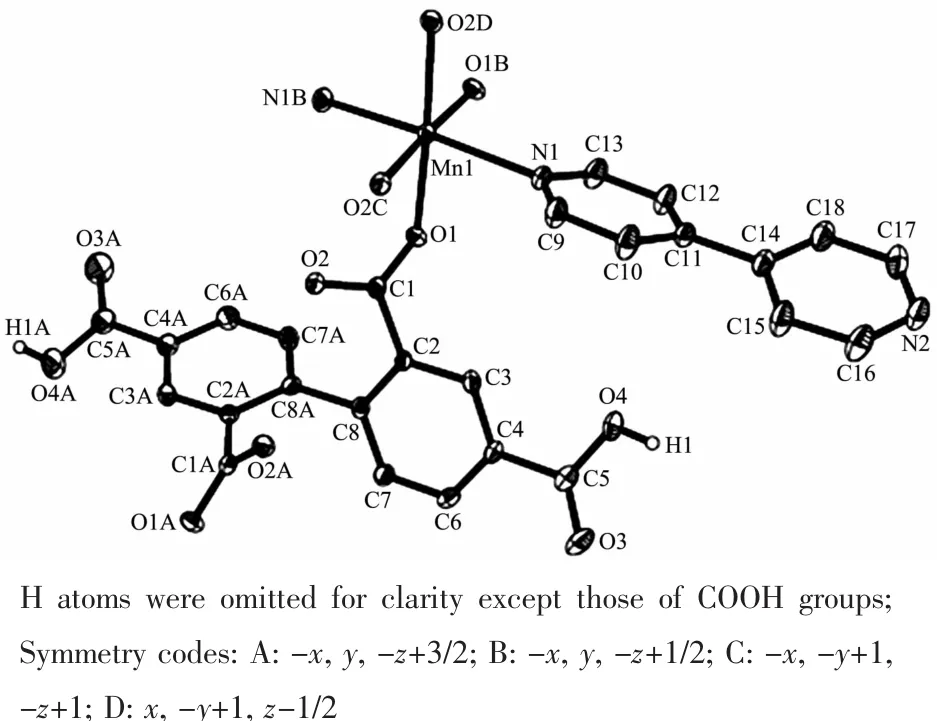
Fig.1 Drawing of the asymmetric unit of complex 1 with 30%probability thermal ellipsoids
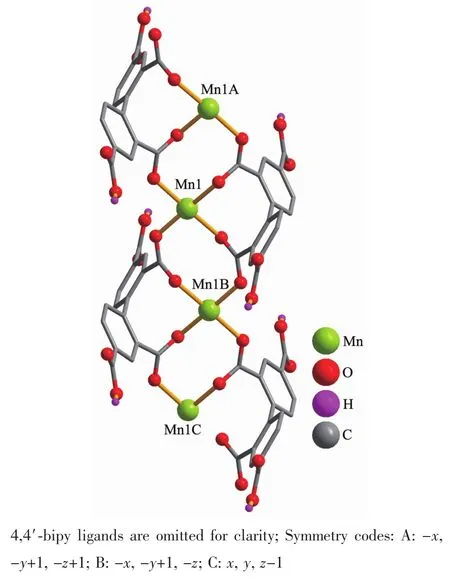
Fig.2 View of a 1D double-helix chain parallel to the ac plane

Fig.3 Perspective of 2D supramolecular network parallel to the ac plane in 1
2.1.2 {[Cu(μ4-3,5-bpta)0.5(2,2′-bipy)(H2O)]·H2O}n(2)
The asymmetric unitof2 consistsofone crystallographically distinct Cu髤ion,a half of one μ4-3,5-bpta4-block,one 2,2′-bipy ligand,one coordinated and one lattice water molecule.As shown in Fig.4,the Cu1 atom is five-coordinated and adopts a distorted quadrangular pyramid {CuN2O3}geometry completed by two carboxylate O atoms from two distinct μ4-3,5-bpta4-blocks and one O atom from the water ligand as well as two N atoms from one 2,2′-bipy ligand.The Cu-O distances range from 0.195 1(4)to 0.228 8(3)nm,whereas the Cu-N distances vary from 0.199 2(5)to 0.200 1(5)nm;these bonding parameters are comparable to those observed in other Cu髤complexes[13,16-17].In 2,the 3,5-bpta4-block acts as a μ4-spacer(modeⅡ,Scheme 1),in which all carboxylate groups exhibit the μ1-η1∶η0monodentate modes.In the 3,5-bpta4-,two benzene rings are coplanar.The carboxylate groups of the 3,5-bpta4-ligands multiply bridge the adjacent Cu髤ions to form a 2D sheet(Fig.5).

Fig.4 Drawing of the asymmetric unit of complex 2 with 30%probability thermal ellipsoids

Fig.5 Two-dimensional metal-organic framework along the a axis in complex 2
2.2 TGA analysis
To determine the thermal stability of complexes 1 and 2,their thermal behaviors were investigated under nitrogen atmosphere by thermogravimetric analysis(TGA).As shown in Fig.6,The TGA curve of 1 indicates that the complex is stable up to 346℃,and then decompose upon further heating.The TGA curve of 2 reveals that one lattice and one coordinated water molecule is released between 40 and 120℃(Obsd.8.1%;Calcd.8.5%),and the dehydrated solid begins to decompose at 250℃.
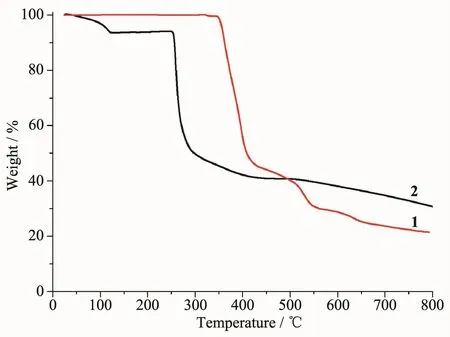
Fig.6 TGA plots of complexes 1 and 2
2.3 Magnetic properties
Variable-temperature magnetic susceptibility studies were carried out on powder sample of complex 1 in the 2~300 K temperature range.As shown in Fig.7,the room temperature value of χMT(4.41 cm3·mol-1·K)is close to that expected for one magnetically isolated high-spin Mn髤 ions (4.38 cm3·mol-1·K,S=5/2,g=2.0).When the temperature is lowered,the χMT values increase slowly until about 50 K,then increase quickly to 7.39 cm3·mol-1·K at 2.0 K.Between 2 and 300 K,the magnetic susceptibilities can be fitted to the Curie-Weiss law with C=4.50 cm3·mol-1·K and θ=3.80 K.These results indicate a ferromagnetic interaction between the adjacent Mn髤centers in complex 1.We tried to fit the magnetic data of 1 using the following expression for a 1D Mn髤chain[19]:
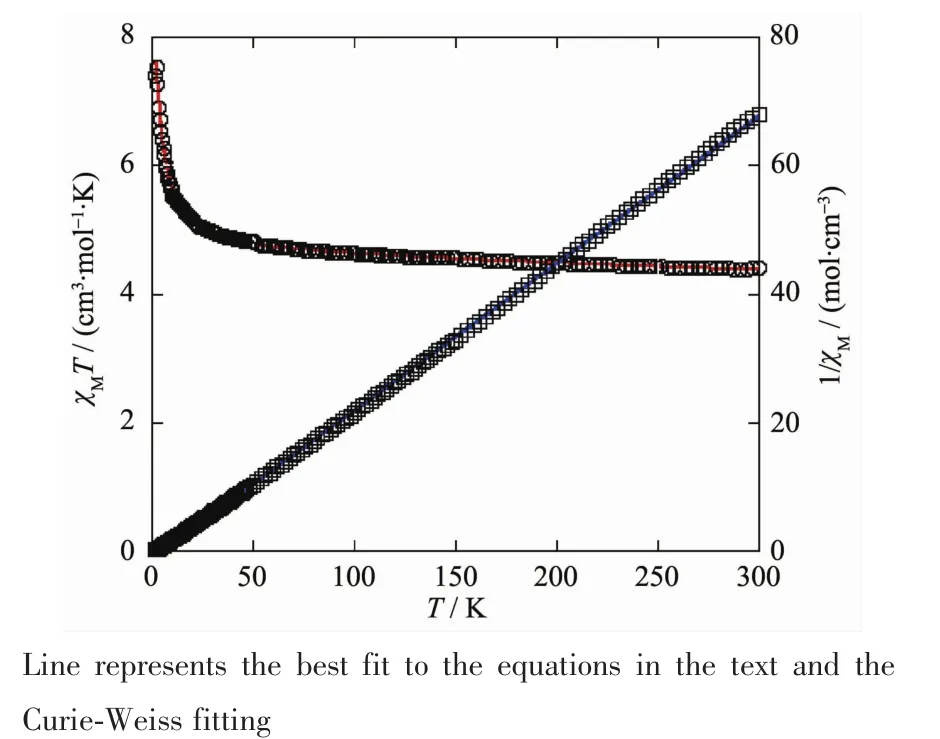
Fig.7 Temperature dependence of χMT(○)and 1/χM(□)for complex 1

Using this rough model,the susceptibilities were simulated,leading to J=+2.87 cm-1,g=2.03.The positive J parameter indicates that a weak ferromagnetic exchange coupling exists between the adjacent Mn髤 centers in 1,which is agreement with positive θ value.According to the structure of 1(Fig.2),there is one magnetic exchange pathway within the chain through two syn-anti carboxylate bridges,which could be responsible for the observed ferromagnetic exchange.
3 Conclusions
In summary,two new coordination polymers,namely[Mn(μ3-2,4-H2bpta)(4,4′-bipy)2]n(1)and{[Cu(μ4-3,5-bpta)0.5(2,2′-bipy)(H2O)]·H2O}n(2),have been synthesized under hydrothermal conditions. The complexes feature the 1D double-helix chain and 2D sheet structures,respectively.Magnetic studies show a ferromagnetic coupling between the adjacent Mn髤centers.
[1]Catala L,Mallah T.Acc.Chem.Res.,2017,50:805-813
[2]He C B,Liu D M,Lin W B.Chem.Rev.,2015,115:11079-11108
[3]Li J R,Sculley J,Zhou H C.Chem.Rev.,2012,112:869-932
[4]Cui Y,Yue Y,Qian G,et al.Chem.Rev.,2012,112:1126-1162
[5]Kuppler R J,Timmons D.J,Fang Q R,et al.Coord.Chem.Rev.,2009,253:3042-3066
[6]Ji P F,Manna K,Lin Z,et al.J.Am.Chem.Soc.,2016,138:12234-12242
[7]Manna P,Das S K.Cryst.Growth Des.,2015,15:1407-1421
[8]Gu J Z,Gao Z Q,Tang Y.Cryst.Growth Des.,2012,12:3312-3323
[9]Gu J Z,Wu J,Lü D Y,et al.Dalton Trans.,2013,42:4822-4830
[10]Li Q Q,Zhang W Q,Ren C Y,et al.CrystEngComm,2016,18:3358-3371
[11]Huang Y Q,Chen H Y,Li Z G,et al.Inorg.Chim.Acta,2017,466:71-77
[12]Huang Y Q,Wan Y,Chen H Y,et al.New J.Chem.,2016,40:7587-7595
[13]Gu J Z,Liang X X,Cui Y H,et al.CrystEngComm,2017,19:117-128
[14]Li S D,Lu L P,Su F.Chin.J.Struct.Chem.,2016,35:1920-1928
[15]GU Jin-Zhong(顾金忠),GAO Zhu-Qing(高竹青),DOU Wei(窦伟),et al.Chinese J.Inorg.Chem.(无机化学学报),2009,25(5):920-923
[16]Su F,Lu L P,Feng S S,et al.Dalton Trans.,2015,44:7213-7222
[17]Tian H,Wang K,Jia Q X,et al.Cryst.Growth Des.,2011,11:5167-5170
[18]Spek A L.Acta Crystallogr.Sect.C,2015,C71:9-18
[19]Mahata P,Natarajan S,Panissod P,et al.J.Am.Chem.Soc.,2009,131:10140-10150
Syntheses,Crystal Structures and Magnetic Properties of 1D Manganese髤and 2D Copper髤Coordination Polymers Constructed from Biphenyl Tetracarboxylic Acid
CHEN Jin-Wei1WEN Bing-Song2CAO Fang-Li2QIU Wen-Da3LI Yu*,3CHEN Xiao-Ling*,2
(1School of Light Chemical Engineering,Guangdong Industry Polytechnic,Guangzhou 510300,China)
(2School of Chemical Engineering and Light Industry,Guangdong University of Techlonogy,Guangzhou 510006,China)
(3School of Eco-Environmental Engineering,Guangdong Industry Polytechnic,Guangzhou 510300,China)
One-dimensional manganese髤 and two-dimensional copper髤 coordination polymers,namely[Mn(μ3-2,4-H2bpta)(4,4′-bipy)2]n(1)and{[Cu(μ4-3,5-bpta)0.5(2,2′-bipy)(H2O)]·H2O}n(2),have been constructed hydrothermally using 2,4-H4bpta(2,4-H4bpta=biphenyl-2,2′,4,4′-tetracarboxylic acid),3,5-H4bpta(3,5-H4bpta=biphenyl-3,3′,5,5′-tetracarboxylic acid),4,4′-bipy(4,4′-bipy=4,4′-bipyridine)or 2,2′-bipy(2,2′-bipy=2,2′-bipyridine),and manganese or copper chlorides.Single-crystal X-ray diffraction analyses reveal that the two complexes crystallize in the monoclinic system,space group P21/c or C2/c.In complex 1,the carboxylate groups of 2,4-H2bpta2-ligands bridge alternately neighboring Mn髤ions to form a double-helix chain.Adjacent chains are assembled to a 2D supramolecular network through O-H…N hydrogen bond.Complex 2 shows a 2D sheet.Magnetic studies for complex 1 demonstrate a ferromagnetic coupling between the adjacent Mn髤centers.CCDC:1560401,1;1560402,2.
coordination polymer;hydrogen bonding;tetracarboxylic acid;magnetic properties
O614.121;O614.71+1
A
1001-4861(2017)12-2322-07
10.11862/CJIC.2017.229
2017-07-06。收修改稿日期:2017-08-23。
广东省高等职业院校珠江学者岗位计划(2015)、广东省自然科学基金(No.2016A030313761)、广东轻院珠江学者人才类项目(No.RC2015-001)、生物无机与合成化学教育部重点实验室开放基金(2016)和教育部职业教育高分子专业教学资源库项目(2015-17)资助。
*通信联系人。 E-mail:liyuletter@163.com,ggcxl@163.com
